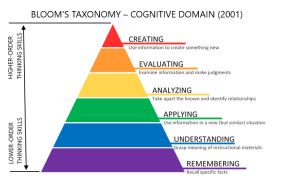Metacognitive learning strategies
Students who are taught metacognitive learning strategies become better learners. In 1976 John H. Flavell coined the term metacognition, which he described as being cognizant of one’s own learning processes, or thinking about your own thinking. Teaching students to have an awareness of how their own learning and thinking happens has been shown to result in improved retention, application, and evaluation of materials in any discipline (McQuire, 2015; Lang, 2016; Ambrose, Bridges, et al, 2010).
There are many resources about metacognition and how it can help students be more academically successful. Here’s an example of how one strategy has been used to improve student learning for over 20 years.
Bloom’s Taxonomy, originally published in 1956 as a framework for categorizing educational goals, can help students develop ways to understand, analyze and synthesize knowledge. “It is a model of learning that focuses not on content and instruction, but on how students think, and how best to promote cognition and understanding in students” (emporia.edu).
In her book, Teaching Students How to Learn (2015), Dr. Saundra McGuire explains why she teaches Bloom’s Taxonomy (see revised 2001 diagram) to her students and how it has had a positive impact on their learning. Dr. McGuire’s students discovered that when they understood more about how they were learning, they demonstrated the higher-order-level thinking skills of analyzing, applying, evaluating, and creating, and their test scores improved (p. 181). She explains, “They began to have learning goals instead of GPA goals” (p. 37). Her students acknowledged that understanding how they learn allows them to not just sort of remember concepts, they are able to recreate knowledge and apply it in new ways – retaining the knowledge far longer, helping to build a lasting knowledge base.
I was excited to learn more about how we learn from an open online course, Learning How to Learn. The presenters explain concepts that can help anyone achieve higher-order-level thinking skills by understanding better how learning happens. They share principles about how metacognitive learning happens using strategies such as previewing, retrieval, questioning, spaced repetition, interleaving, focused and dispersed learning, handling procrastination, and memory techniques. Many of these concepts are also shared in Dr. James Lang’s book, Small Teaching: Everyday lessons from the Science of Learning.
Teaching metacognitive learning strategies such as these give students an advantage over what they have previously been conditioned to do. Helping them understand how they learn can improve their ability to do well in academics, be creative, think critically, and be more effective problem-solvers, which better prepares them for the future.
When I share metacognitive learning strategies with students, I see the AHA moments they experience as they gain new understandings about how they think and learn. I encourage you to check out the resources I’ve mentioned and more. If you have questions or comments, or would like to discuss and/or share metacognitive learning ideas and strategies, please be in touch.
Resources mentioned:
- How Learning Works: 7 research-based principles for smart teaching, Ambrose, Bridges, Lovett, DiPietro, & Norman
- Metacognitive aspects of problem solving. Flavell
- Small Teaching, Lang
- Teach Students How to Learn: Strategies You Can Incorporate Into Any Course to Improve Student Metacognition, Study Skills, and Motivation, McGuire
- Learning How to Learn, https://www.coursera.org/learn/learning-how-to-learn
Kristin Halsey is a member of the dynamic team of educators in the Center for Teaching and Learning.
